In 2017, following the sacking of Corinne Diacre – the first female manager to coach in the first two tiers of a men’s European league – Clermont Foot 63 turned to reserves manager Pascal Gastien to become the club’s new head coach.
Gastien was not a well-known name in France by any stretch of the imagination and had managed just two professional clubs in his career, Chamois Niortais, and LB Châteauroux respectively.
Clermont were going through managers at rapid speed as none were performing well enough with the squads at their disposal but with a sixth-place finish in his first season in charge, Gastien proved he was more than capable of bringing glory to the French outfit.
This was followed up by a disappointing tenth-place finish in 2018/19, a respectable fifth-place in 2019/20, and finally, after many years of trying, Clermont managed to reach France’s top-flight division for the first time in the club’s 111-year history since its foundation.
Gastien’s men are no pragmatists though and play some of the most exciting and attacking football in European football at the moment despite being in the bookies’ top-three favourites to go straight back down prior to the season commencing.
As of writing, the team are sitting sixth in Ligue 1 and have blown away any doubters, although there is still a lot of games left to go.
This article will be a tactical analysis of Clermont Foot under Gastien in the form of a team scout report. The analysis will particularly be focusing on their tactics in possession.
*It must be noted that this analysis was written prior to Wednesday night’s game against Rennes and so the statistics may be slightly outdated.*
Formations and Lineups
Gastien’s formation is extremely fluid and there is a heavy emphasis by the French manager on positioning and space occupation as opposed to a rigid structure – a prerequisite for modern positional play.
The 4-2-3-1 has been Clermont’s main base formation this season, playing with one number ‘6’ as the single pivot and two ‘8s’, although the manager has also deployed a 4-2-3-1 and a 4-2-3-1.
That being said, whilst in possession, the three-man midfield works more like a single pivot ‘6’ and two ‘8s’ as opposed to two ‘6s’ and a number ‘10’ which will be analysed in further detail later on.
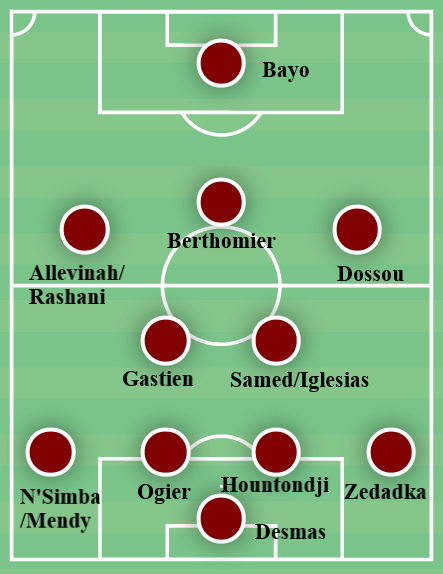
This is Clermont Foot’s first-choice starting eleven this season. Gastien has been quite constant with his selections but there has been a slight bit of rotation within the first eleven.
Arthur Desmas has played every single minute for Clermont this season, behind a centre-back partnership comprising of Cedric Hountondji and Florent Ogier. Akim Zedadka has also started every game so far while Vital N’Simba and Arial Mendy have battled it out for the starting left-back berth.
The midfield double-pivot is an interesting component of Clermont’s starting lineup due to the nepotistic overtones. Pascal Gastien has deployed his son, Johan Gastien in every game so far for the Les Lanciers.
However, Gastien – the player – has proved to be worthy of selection from his father and has been utterly stupendous at times for the newly-promoted side even at the ripe age of 33. Gastien has typically partnered alongside Salis Abdul Samed or Jonathan Iglesias.
Further forward, 31-year-old Jason Berthomier has been one of Clermont’s vital cogs this season so far, flanked by Beninese international Jodel Dossou on the right-wing and either Jim Allevinah or Elbasan Rashani on the left with star-striker Mohamed Bayo up front.
Build-up play
Clermont’s build-up play has been interesting to say the least. The constants are that the centre-backs split wide allowing for the goalkeeper to become involved in the action. However, one centre-back, typically the right central defender, shifts further wide almost like a fullback.
The fullbacks also push very high which facilitates the central defenders pushing wider.
Generally, in the build-up phase, one of the two defensive midfielders will drop next to the goalkeeper and occupy the position of the widest central defender. This creates somewhat of a lopsided back four with the goalkeeper.
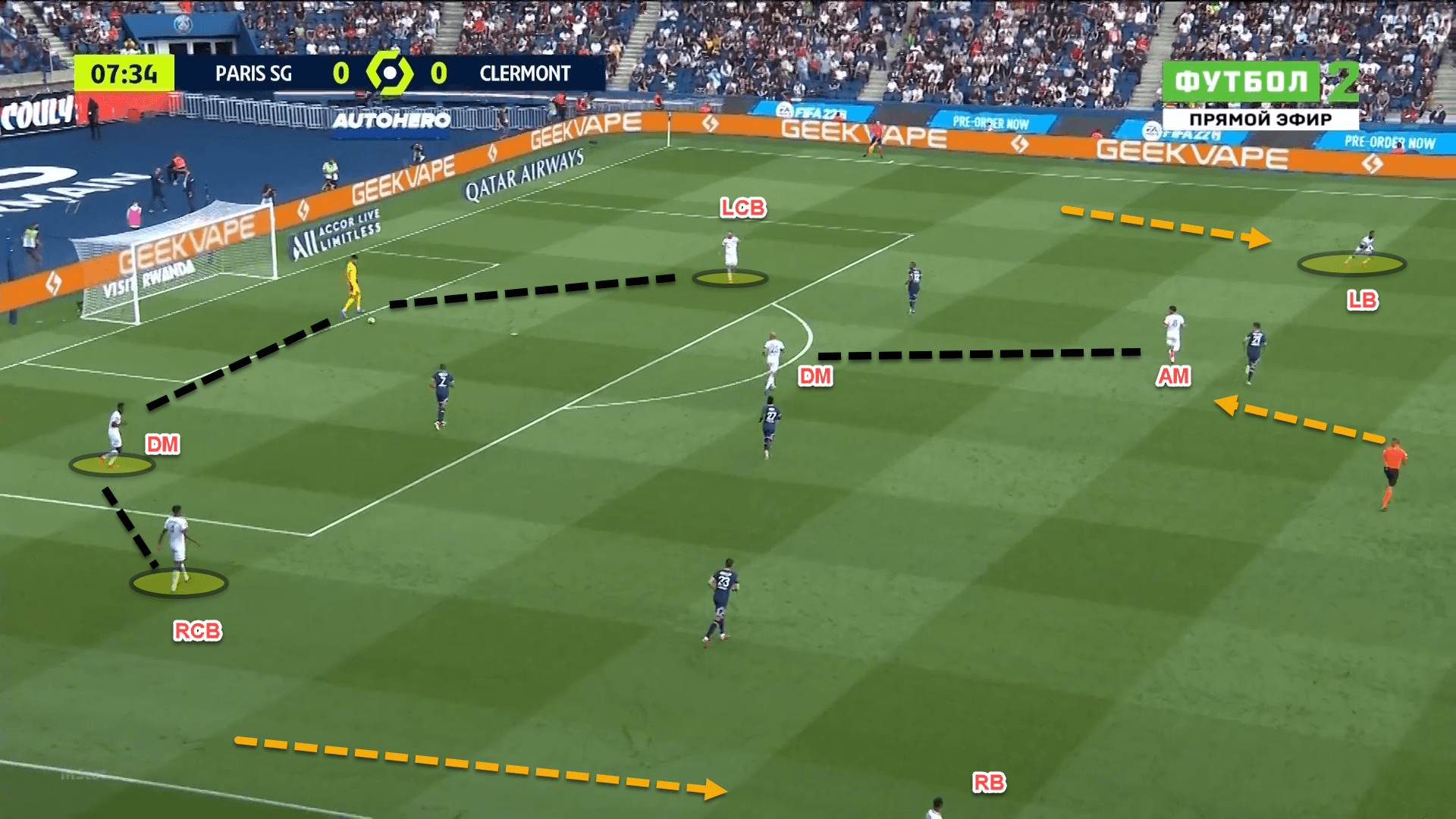
As can be seen from the image above, during this phase of the positional attack, when one of the pivot players drops into the backline, the attacking midfielder will come deeper also in order to occupy the space behind the opposition’s first line of pressure.
Clermont will always have at least seven players in the first third of the field when they are trying to play out from the back in order to ensure a nice and clean progression through the press.
Clermont have been rather impressive in this phase and have not been afraid to take risks in these areas in order to progress the ball. So far in Ligue 1 this campaign, the French outfit have completed the second-highest number of progressive passes per 90 with 70.26 which is more than Paris Saint-Germain.
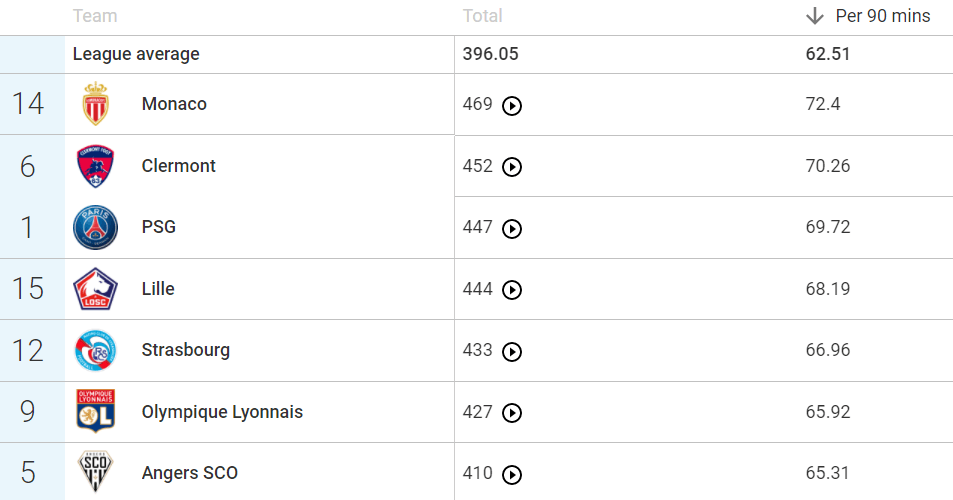
Les Lanciers have also completed the third-highest number of progressive passes in total in Europe’s top five leagues this season with 452. Only Bayern Munich and Monaco have completed more – although they have played one game extra compared to most leagues.
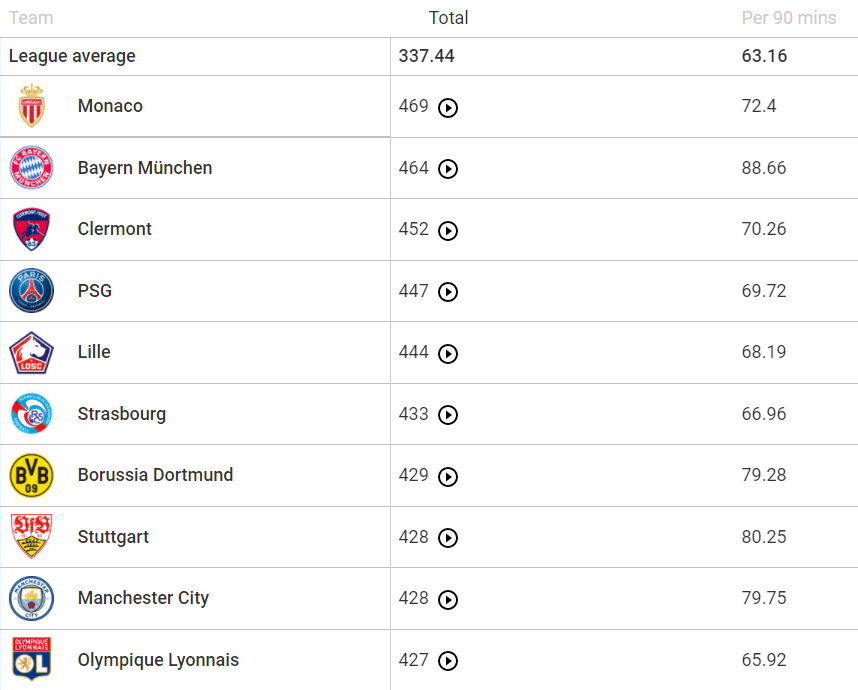
Sometimes though, Clermont will build up slightly differently from the goalkeeper in order to ensure that their play does not become predictable.
At times, they will simply look to split the two centre-backs wide towards the edge of the area, push the fullbacks high up the pitch, and keep the double-pivot together behind the opposition’s first line of pressure.
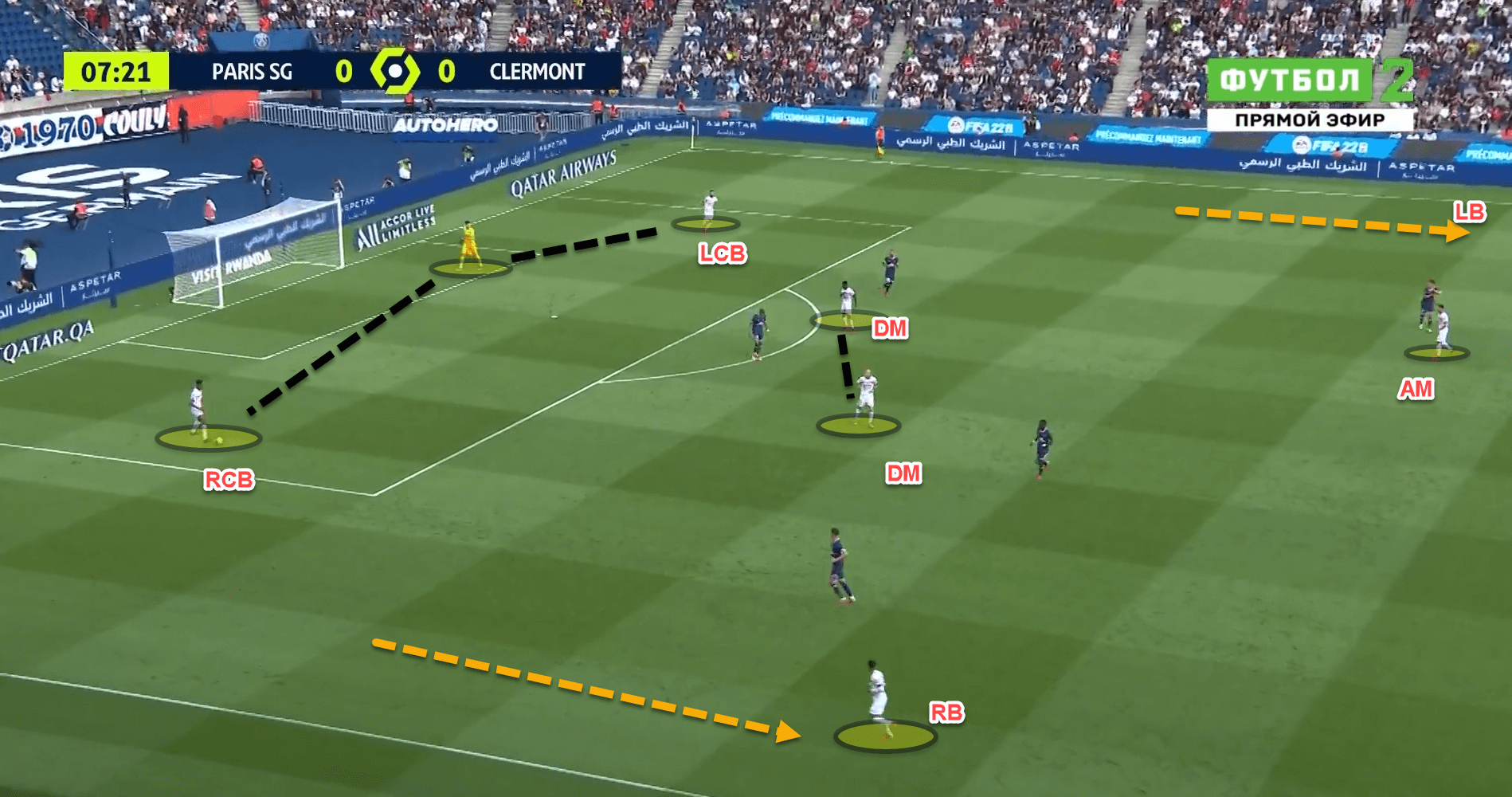
Progressing further up the pitch
Usually, to escape the opponent’s press, Gastien instructs his side to overload the deeper central areas of the pitch. The reason for this is because it will force the opposition to narrow their press which leaves space in the wide areas to play to the fullbacks and escape the pressure.
Gastien – the pivot player – is extremely important in the execution of this because of his wonderful long-range passing ability.
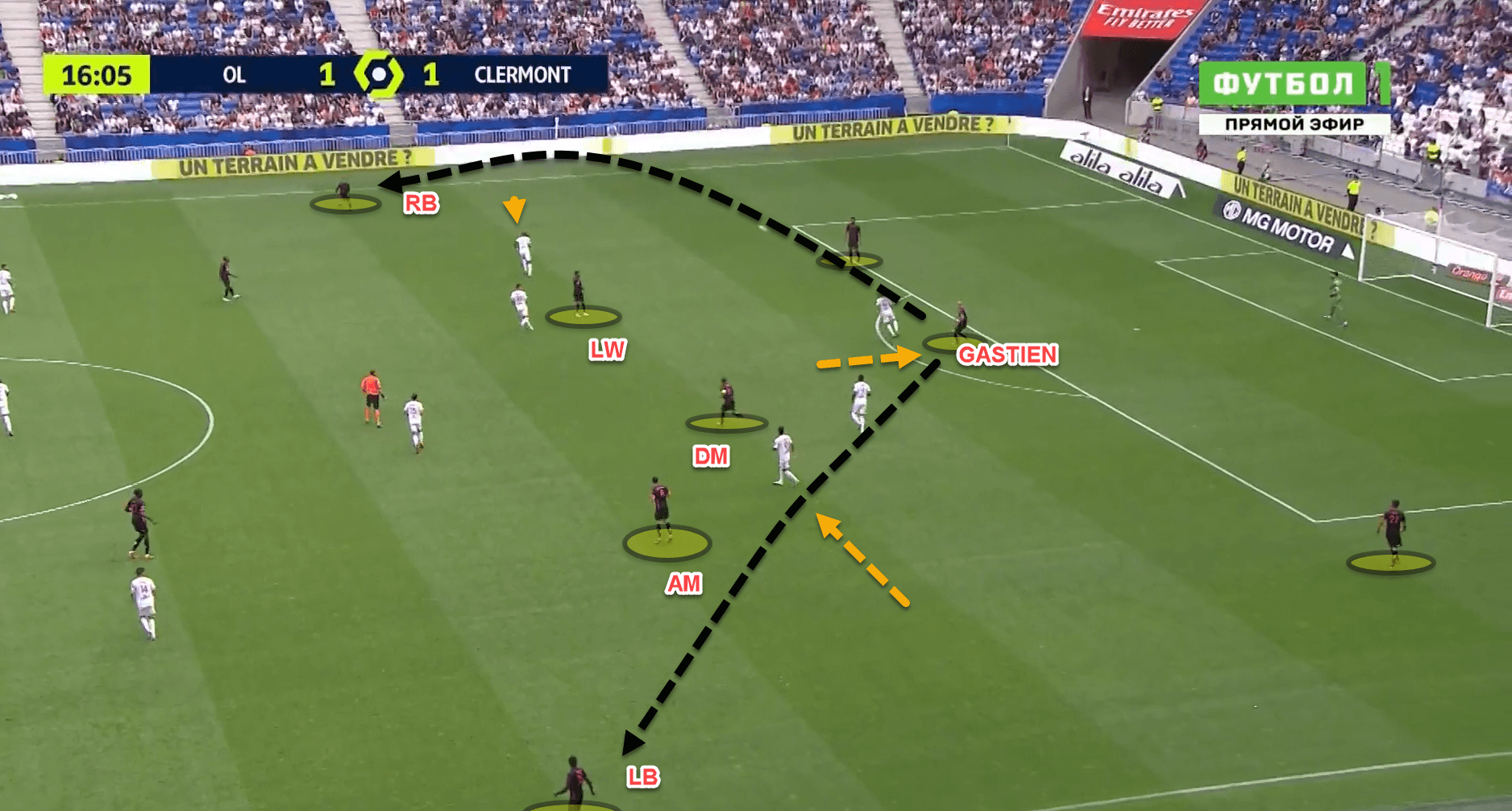
Here, Gastien has dropped into the backline to create a 3v2 numerical superiority against Lyon’s first line of pressure.
Clermont have committed three players really deep in the first third of the pitch which has forced Lyon to narrow their high block, leaving space out wide. Using Gastien and the high fullbacks, Clermont can escape this pressure easily and look to attack the flanks.
When this is pulled off successfully, it can be a very efficient way of getting at an exposed backline as the opponent has committed so many bodies in the pressing phase that there will be gaps to be exploited by runners in behind.
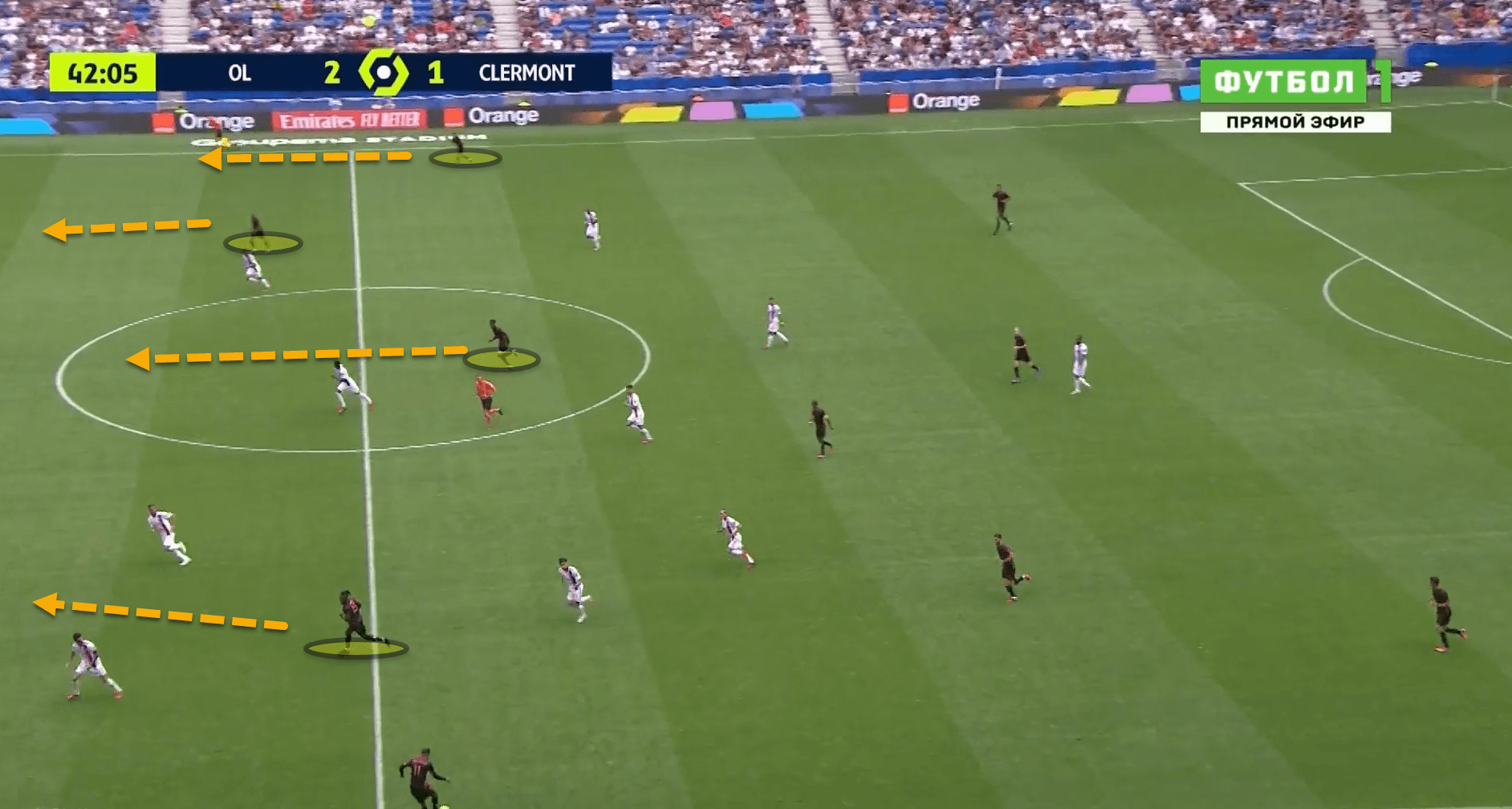
Trying to break into the final third
When Clermont are in a structured positional attack in the middle third of the pitch – also known as the progression phase – the goal is to attack on the flanks.
Clermont Foot have had 167 positional attacks so far in their opening six Ligue 1 matches. 134 of these 167 structured attacks have been down the flanks. 50.75 percent of their wide attacks have been down the right and 49.25 over on the left meaning there is no preference for which side the French team attack down.
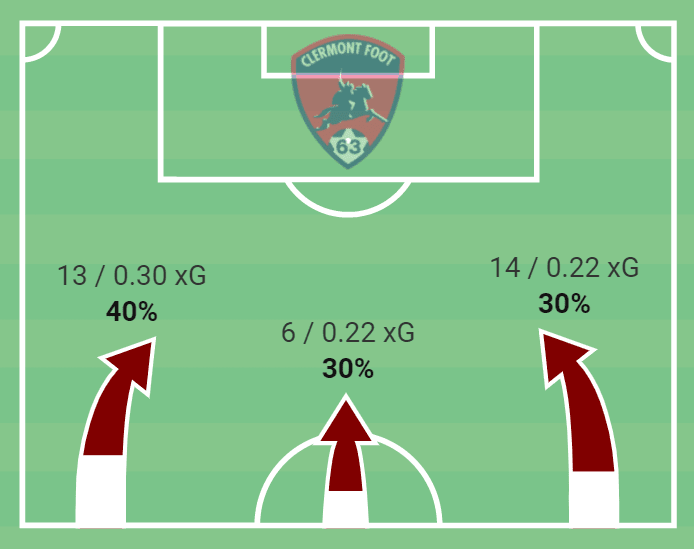
For instance, here is a data visualisation detailing all 33 positional attacks that Clermont had in a recent game against Metz. Merely 6 were through the centre.
There are two ways that Gastien wants his side to break down a medium-to-low level defensive block in order to get into good crossing positions from the wide areas.
Firstly, Clermont overload the wide areas in order to free up players on the far side for a switch of play. As the opposition will shift across to defend against the wide overload, there will be space on the far side to find a player free. This term is called ‘overloading to isolate’.
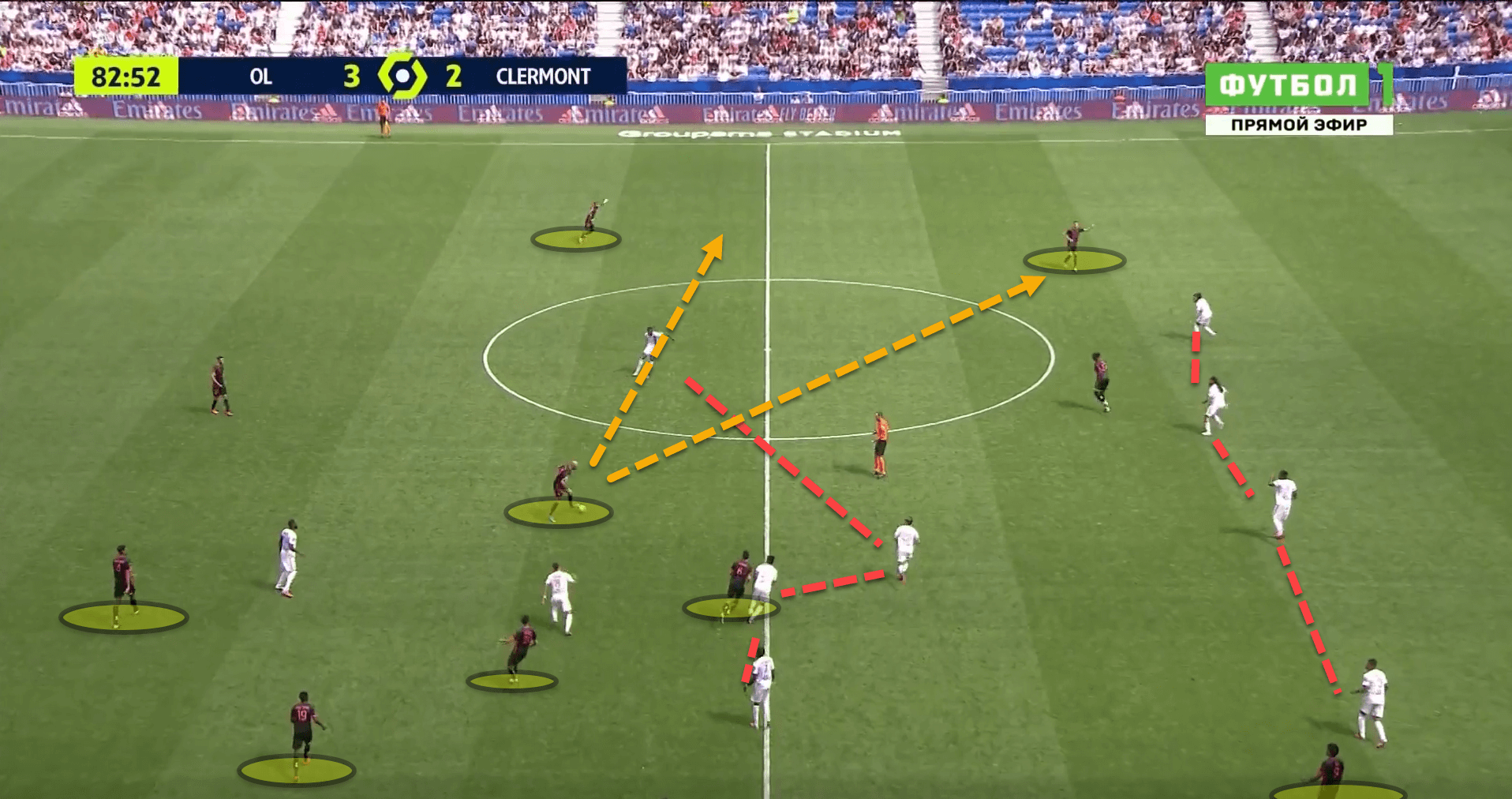
Here, Lyon have pushed across their defensive mid-block to defend against the wide overload on the right flank. In the meantime, this has allowed two Clermont players to pull wide to receive a switch of play and create a 2v1 situation against Lyon’s right-back.
Gastien – the player – is vital here once again due to his wonderful passing range as he can get the ball out of his feet quickly and hit these types of passes to advance his side up the pitch.
The other way the head coach wants his side to break down a defensive block is by playing centrally to players between the lines before using these as wall passes to reach the flanks. The perfect example of this came in a game from Ligue 2 at the end of the previous campaign when Clermont faced SM Caen in a 2-1 defeat.
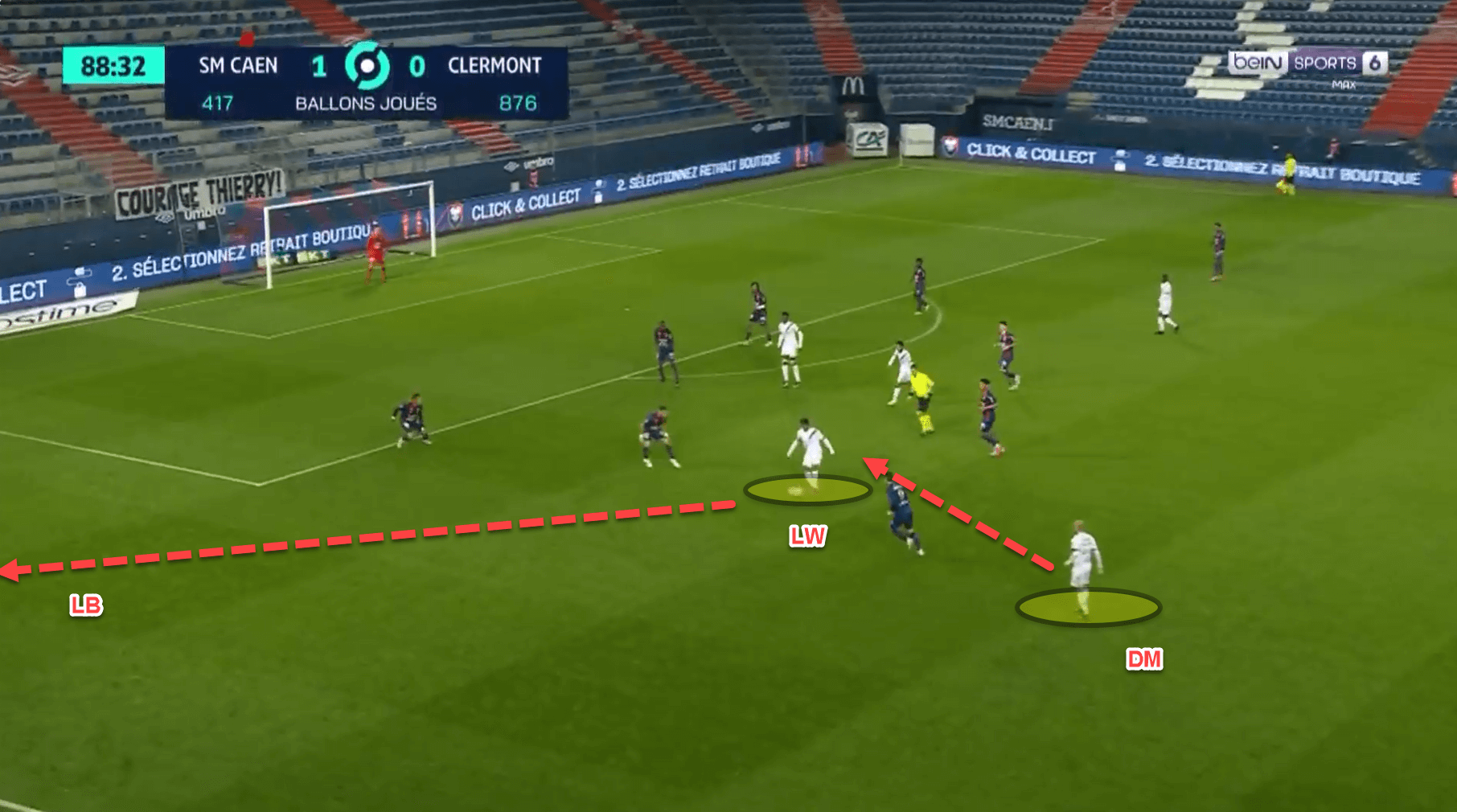
Gastien had managed to play to break the opposition’s lines and find the winger between the opposition’s lines. To avoid giving the wide-player room to turn and run at the backline, the defensive block narrows and compacts itself to give the player little room.
In turn, this leaves space out wide to find the free advancing fullback and this is a constant tactical and positional ploy used by Gastien’s men when trying to break down a defensive block and put crosses into the box.
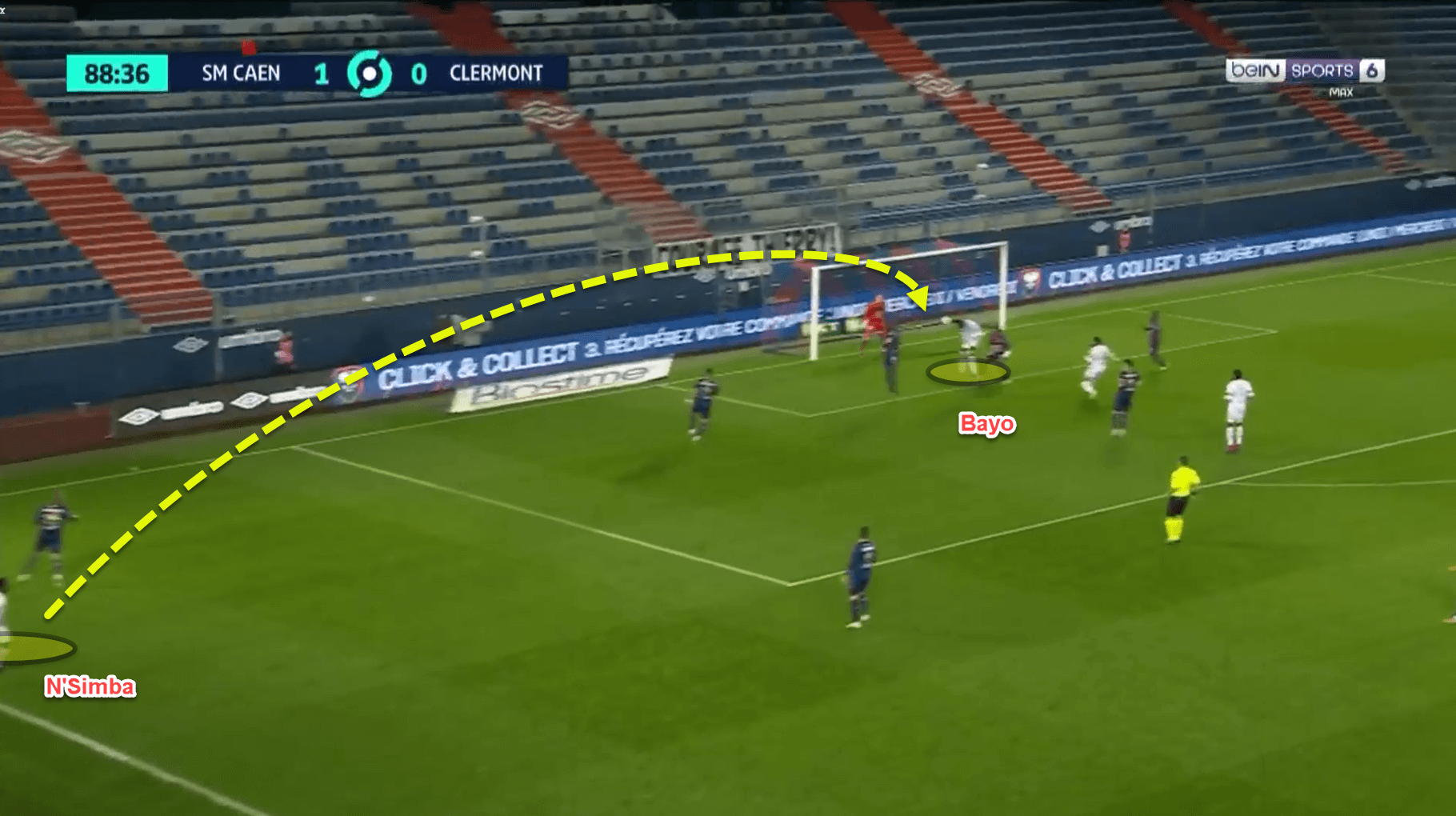
N’Simba received the ball on the left flank and the Caen fullback could not close him down in time because he shifted too far inside when the Clermont winger received the ball, meaning the fullback got plenty of time to pick out a pinpoint cross to Bayo who scored a header to equalise.
Clermont play to their own strengths in this sense. Bayo is very solid in the air, winning 43.3 percent of his aerial duels this season which is quite solid for a centre-forward. On the other hand, Clermont are good at crossing with an accuracy of 34.8 percent in their six games so far this season.
The newly-promoted side are also one of the highest-crossing sides in European football with 122 played so far this season. Only Manchester City have played more crosses in total, but the French side have averaged the ninth-most crosses per 90 across all of Europe’s top five leagues.
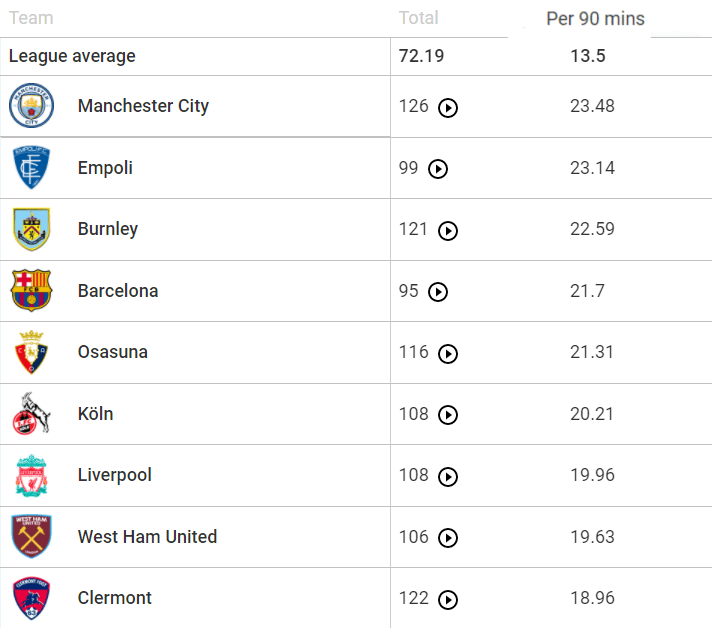
Goals and chances created
A high volume of crosses is one of the main reasons why they average quite a lot of touches in the penalty area per 90 and create a number of excellent chances.
As of writing, Clermont Foot are averaging 18.65 touches in the penalty box per 90 in Ligue 1, which again, is one of the highest in Europe.
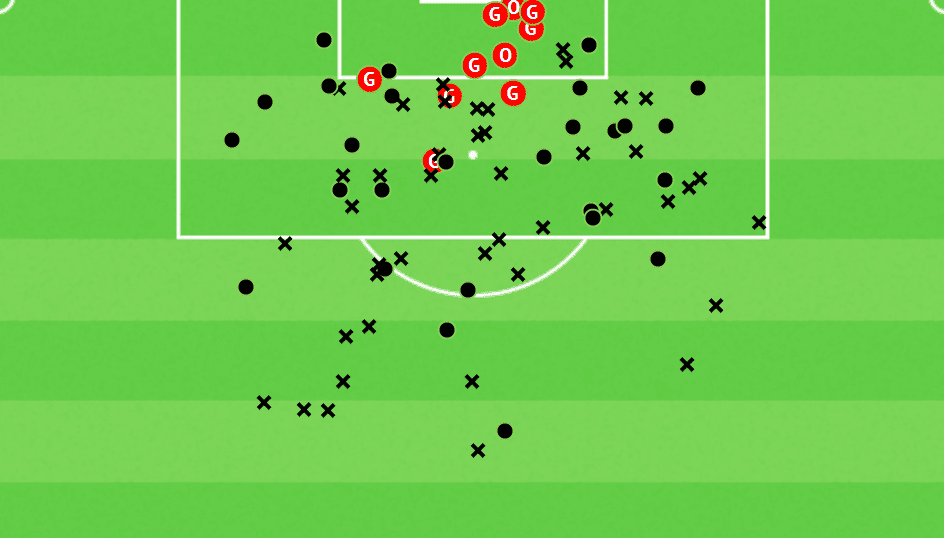
Here is a data visualisation that has plotted all of Clermont’s shots on goal so far in their opening six matches. At first glance, what is quite telling is just how many shots the French club have had since there have been so few games played.
Clermont have scored 10 goals already which is 1.55 per 90. However, they have one of the lowest expected goals per shot ratios in the league, registering an average of just 0.108 xG on each shot. This means that it takes Clermont almost 10 shots to score a goal.
The reason this is a concern is that if the volume of chances reduces that the French club gets per game, the goals may start to dry up so Pascal Gastien will need to ensure that his men try and continue their goal bombardments in every game. Currently, they take 12.28 shots per 90, the third-highest in Ligue 1 behind Marseille and PSG.
Conclusion
It is extremely likely that Clermont Foot will drop off this season as the sample size has been quite small just six games in the Ligue 1 season. However, Gastien has his side playing some sumptuous football, anchored by his son in midfield as the core of the team which is a truly poetic story.
Clermont are fearless, energetic, brash, brave, and bold and are keeping up with the big guns so far. While they may not remain in the top six by May, there is a huge possibility that they could establish themselves as a really solid mid-table club, an excellent foundation for a team that is in the top-flight for the first time ever.






Comments